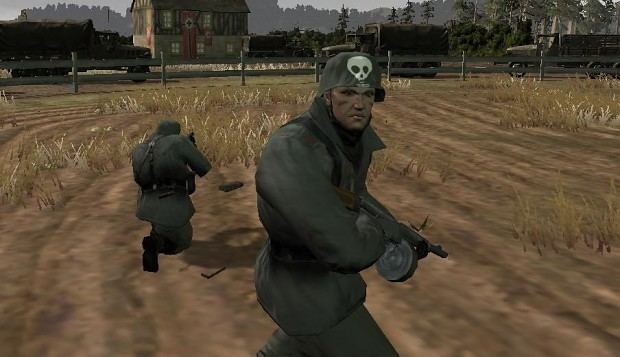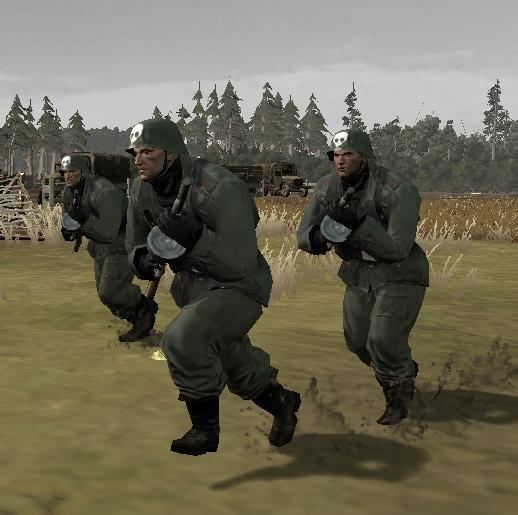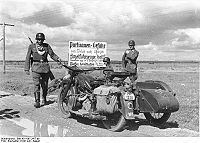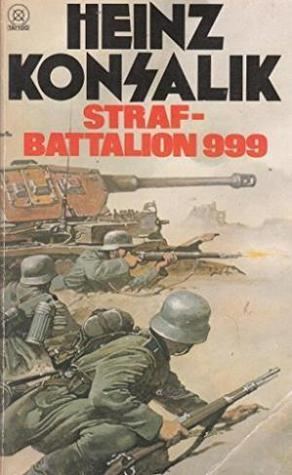Active 1942–1945 Branch Army Role Punishment | Country Nazi Germany Type Penal unit Disbanded May 8, 1945 | |
 | ||
Strafbataillon (English: penal battalion) is the generic term for penal units created from prisoners during the Second World War in all branches of the Wehrmacht. Soldiers and civilian criminals sentenced to these units were generally poorly armed and required to undertake dangerous high-casualty missions. Strafbataillons were operated and administered by the Feldgendarmerie, the German military police.
Contents

By 1943, the course of World War II had turned against Nazi Germany. Due to military losses and the need to maintain discipline by example, the German High Command ordered that further punishment units should be formed from the thousands of Wehrmacht military prisoners held in its military prisons. These Strafbataillon, which were under the control of the Feldgendarmerie, were then used to conduct dangerous operations (sometimes akin to suicide missions) for the Heer such as clearing minefields, assaulting difficult objectives and defending positions against overwhelming attacking forces. They were also made to do manual hard labor in front-line locations, building and repairing military infrastructure and defenses.

Prisoners that survived their missions would be deemed 'fit to fight' and returned to the field with the 'rights' of a combat soldier. Although Strafbataillon were mainly used on the Eastern Front, some were sent to the Ardennes on the Western Front during the last major German offensive in December 1944.

Formation

The Strafbataillon were developed from the Sonderabteilungen (English: special departments) that existed in pre-war Nazi Germany. Initially, Nazi policy was to rebuild the armed forces by keeping "potential troublemakers" away from the troops and removing any "destructive elements" from military service. But on 21 May 1935, Adolf Hitler decreed that under the new Nazi Defence Act any conscript who was deemed "unfit for military service because of subversive activity" would be arrested. However soldiers who were deemed disruptive to military discipline but were otherwise "worthy of service" would be sent to military Sonderabteilungen.

These units were designed to change attitudes toward state and national policy while instilling a sense of duty, honor and purpose. These goals were to be achieved through harsh discipline and punishments, extensive indoctrination programs and restrictions on home leave. Troops who conformed were eventually transferred to regular units. However those who continued to show indiscipline or opposed the military were transferred to Sachsenhausen concentration camp. Before World War II, there were nine Sonderabteilungen within the Wehrmacht in Nazi Germany. According to estimates, between 3000-6000 Wehrmacht personnel passed through these special departments. A total of 320 "incorrigible pests" were transported to concentration camps.
However, with the outbreak of war in 1939, the Sonderabteilungen were disbanded. They were replaced with the Feld-Sonder Battalion (English: Special Field Battalion) under the control of the Feldgendarmerie. However, as the war continued, the need for more military personnel grew accordingly. Military tribunals were directed by the OKW to send incarcerated members of the Wehrmacht as well as "subversives" to Bewährungsbataillone (English: probation battalions) at the front.
Bewährungsbataillon 500
The 500th Probation Battalion was created by a secret Führer directive in December 1940. The order stated that any first-time convicted soldier could return to his unit after he had served a portion of his sentence in "a special probation corps before the enemy". However recidivist criminals and hardcore elements in the German prison system were not allowed to join these units. Beginning in April 1941, convicted soldiers - even those sentenced to death - who had shown exceptional bravery or meritorious service were allowed to rejoin their original units. However those in probation units were expected to undertake dangerous operations at the front. Refusal entailed execution of the original sentence. Those who did refuse were labelled "criminal entities" and sent to the harsh moorland labor camps in Emsland in Lower Saxony. There was a strong incentive to join Bewährungsbataillon because convicted soldiers lost both their honour and citizen's rights. The only way to get their rights back was probation in Bewährungsbataillon 500.
During World War II, more than 27,000 soldiers served a probation period in a Bewährungsbataillon unit. They were monitored and commanded by selected officers, NCOs and assigned enlisted men who made up a quarter of the total strength. Although battle losses were high, the desire to win the right to leave probation meant combat morale was high. Major operations conducted by Bewährungsbataillone on the Eastern Front include Kamianka, Ukraine as well as at Gruzino and Sinyavino near Leningrad.
Bewährungstruppe 999
In October 1942, the 999th Light Afrika Division was formed from civilian criminals and prison inmates who had been deemed "unfit for military service". They were encouraged to volunteer on the promise that all past crimes would be wiped out by exemplary bravery in combat. However anyone who refused to join the Bewährungstruppe (English: probation troop) would stay in prison without rights to parole or be sent to a concentration camp.
A third of the 28,000 troops that joined the division were political prisoners from Baumholder and Heuberg. The 999th Light Afrika Division initially fought in North Africa and later in the Soviet Union. Some units were also used as garrison troops in Greece and in the fight against partisans in the Balkans. However several hundred soldiers from the division deserted to the Allies. In September 1944 some troops from the 999th, including Falk Harnack and Gerhard Reinhardt took active part in armed resistance with the Greek Liberation Army (ELAS).
Final years
In the final years of the war, order within all branches of the Wehrmacht was upheld by a specially-formed military police, the Feldjägerkorps. These military police units, which had seniority over all other Feldgendarmerie, were formed from combat-decorated officers and NCOs. Possessing the direct authority from the OKW, they had the power to maintain control and discipline throughout all the German armed forces including the SS. The Feldjägerkorps had the authority in the field to summarily execute officers or enlisted men for any breach of military discipline, order or duty. By September 1944, all soldiers and recruits who received a sentence of deferred execution in a drumhead court-martial were sent directly to Strafbatallions. Numbers rapidly increased as the war drew to a close in May 1945.
In popular culture
Author Helmut Jung in his book, But Not for the Führer described the Strafbatalion as a "prolonged death". Danish writer, Sven Hassel, uses the Strafbataillon in many of his novels about the Wehrmacht on the Eastern Front.
The fictional unit of disgraced German paratroopers sent to kill British Prime Minister Winston Churchill in The Eagle Has Landed by Jack Higgins are also recruited from a Wehrmacht penal unit.
In the German TV miniseries Generation War a character who deserts from the Wehrmacht is sentenced to serve in Bewährungsbataillon 500.
